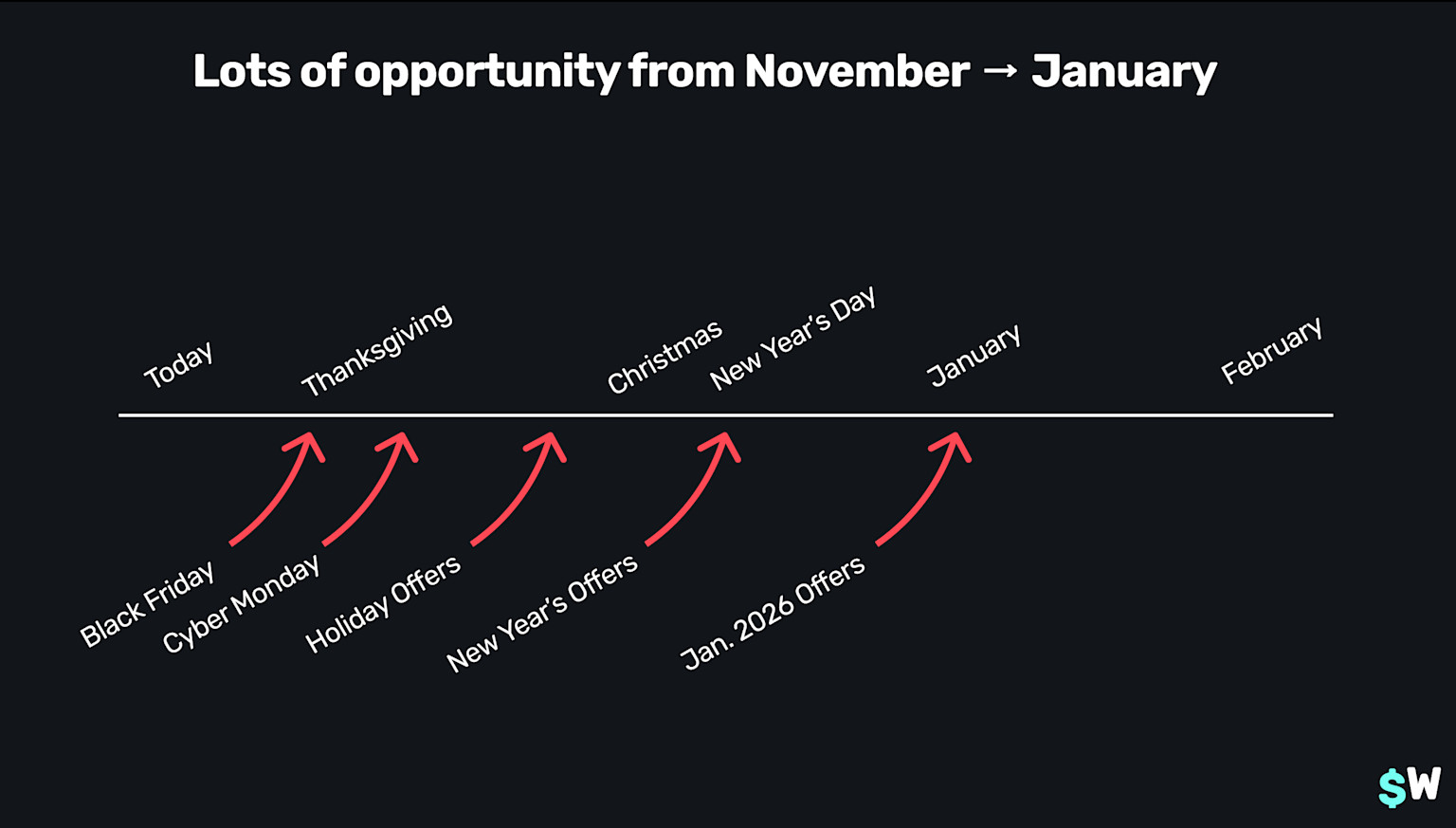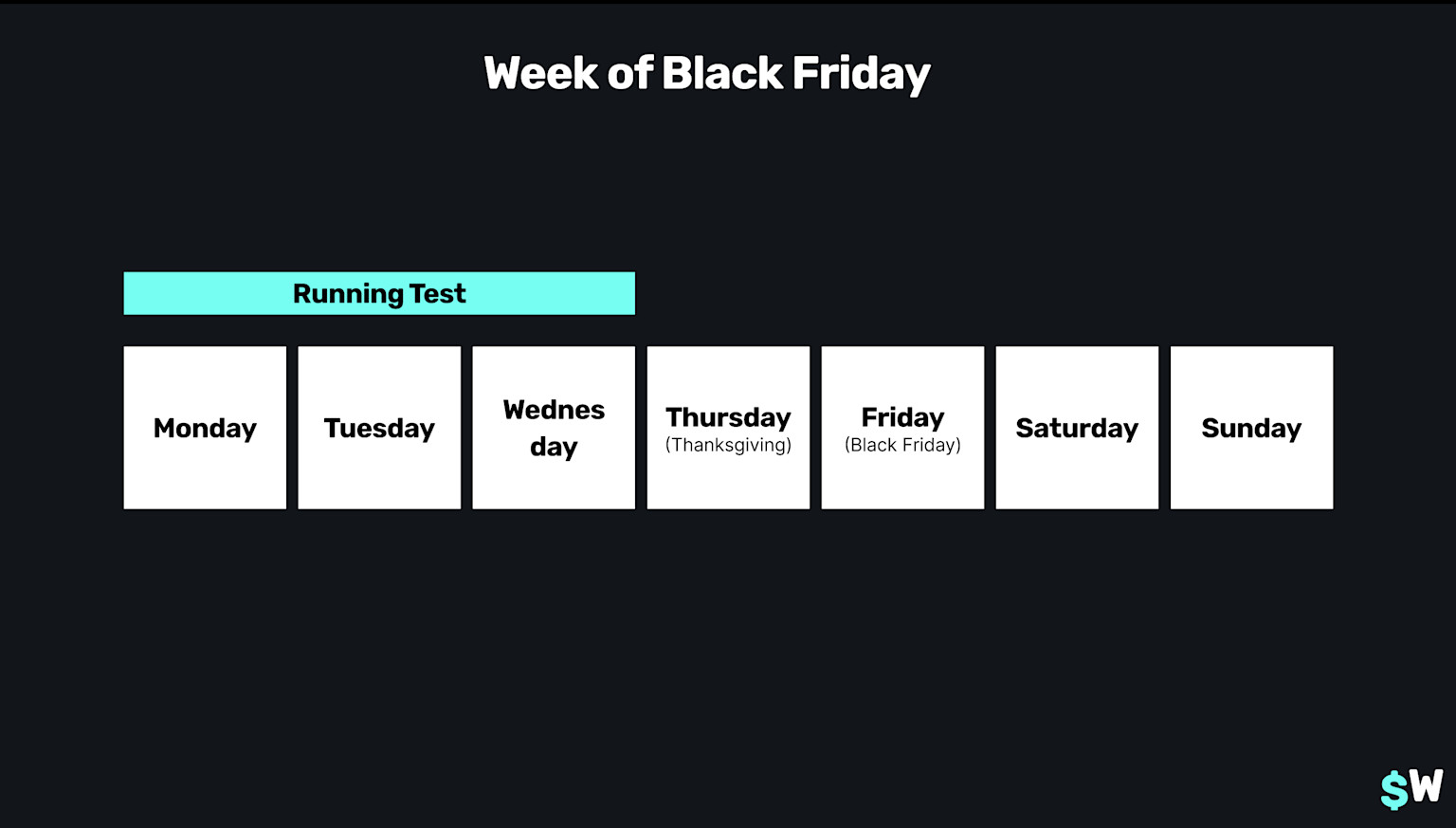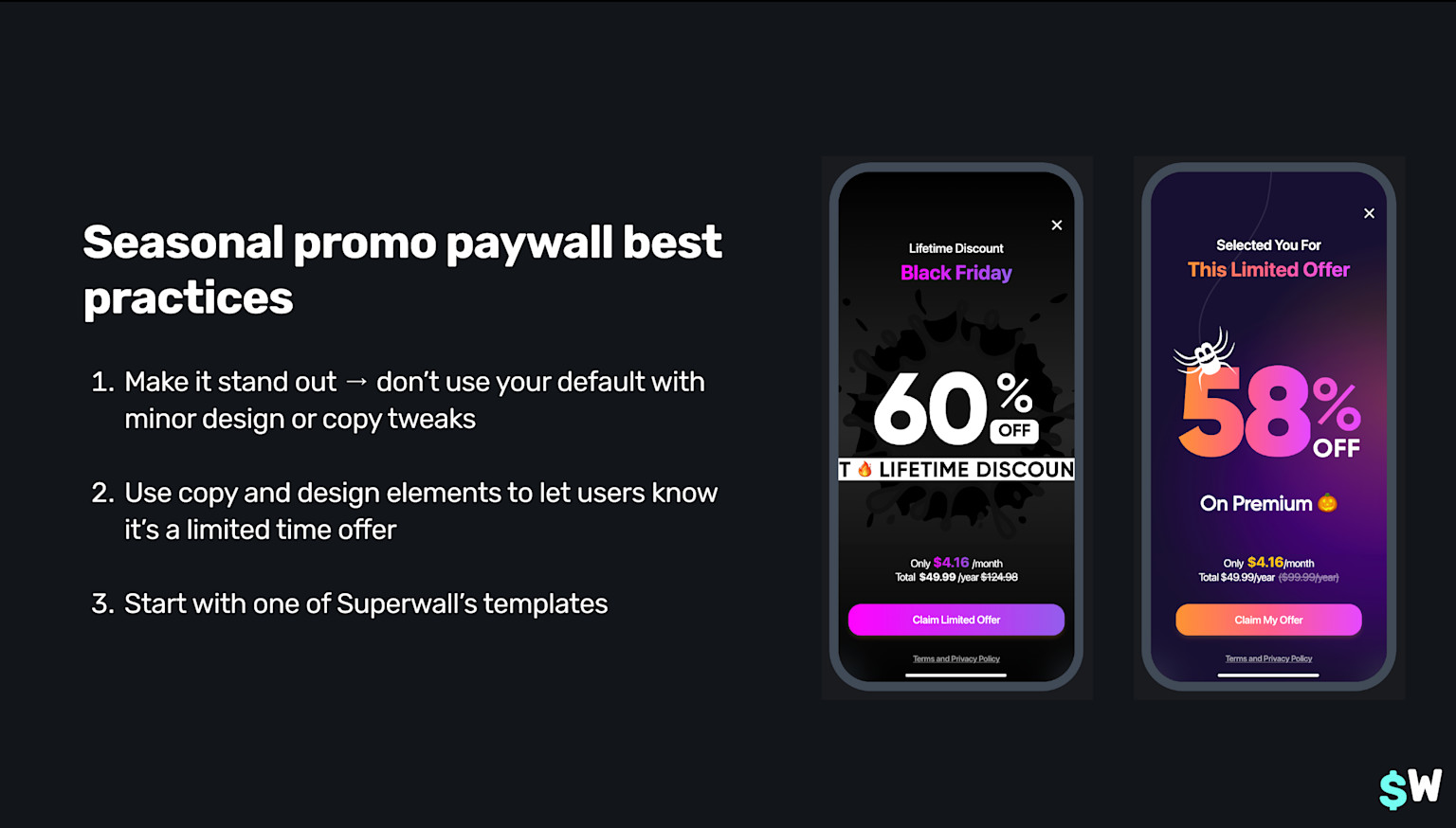In today's growth session, Nick dropped a ton of actionable insight on how to take advantage of seasonal offers. The next ones up for app founders? Black Friday and Cyber Monday. Plus, he covered some things to think about in terms of new year install boosts. How do you turn them into paying users? How are they different? Do seasonal offers eat into regular revenue?
As always, here are resources from the session:
Don't miss our next growth session either! You can always RSVP using our public calendar here.
As for now, here's a recap of Nick's main points, followed by some community Q and A.
The next three months are packed with opportunity
The landscape between now and early next year looks chaotic at first glance, but it's actually a series of distinct revenue opportunities if you treat them correctly. Nick walked through how Black Friday has evolved from a single day into basically an entire week-long event in e-commerce. The same thing's happening with Cyber Monday. That extends to the app world now, obviously. Plus you've got the holiday season rolling into New Year's, and finally that massive January install spike that some "resolution" type of apps (like fitness) categories experience.
Here's where most apps get it wrong, though. They tend to treat all of these moments the same. Same offer, same design, same messaging blasted to everyone via email, push notifications, and interstitials. That's not tactical. Each of these windows deserves its own strategy, its own audience targeting, and its own offer structure. It's not that much additional effort to treat them as separate opportunities, and the payoff is worth it.
So, don't try to push what you have. Come up with a unique offer for a unique part of the year that only comes around once.
How to run experiments when time is compressed
During normal periods, you might plan a test for two weeks, analyze results, then run another test for a week. But seasonal moments demand a completely different testing cadence.
Nick's recommendation is to narrow things down dramatically. Run just two variants over a very short window, perhaps Monday through Wednesday of Black Friday week. The goal isn't to find the best performer for the next year, but rather it's to identify what will maximize conversions during this specific, compressed timeframe.
So, why only two variants?
You need to maximize the data you can collect in each variant while limiting the time it takes to get signal that one is better than the other. You might not be able to prove long-term statistical significance, but that's okay. You're optimizing for what converts best and maximizes revenue over the next month, not the next twelve months. Then, once you've figured that out, you take the winner and run it at 100% for the remainder of the seasonal window.
Of course, along with offers, the next natural question to ask is, "What should these paywalls look like?" To that end, don't simply repurpose your existing paywall! Use new, eye-catching designs. Users may have seen your existing paywall several times, and just changing the price of copy won't get it done. Consider some of these high performers we've used:
By the way, the same testing principle apply to January. Run a tight test right after Christmas or during the first week of January, pick your winner, and ride that for the entire month while those install numbers are elevated. You might squeeze in one or two additional short tests during January, but the priority is maximizing the time your best performer is live while you're getting 2x or even 2.5x your normal install volume.
What January's install spike really means
For fitness apps, the data is obvious. Nick shared an example showing 2.5x install volume during January compared to baseline. But it's not just fitness. Reader apps, productivity tools, and plenty of other categories see meaningful bumps when people commit to New Year's resolutions or fresh starts. Habit trackers are another one.
The critical question isn't whether you'll see a spike, it's whether you're prepared to capitalize on it. Plan for it! That means having your offers tested and ready before the spike hits. It means thinking through who you're targeting and what you're offering them. Every new user coming in during January should be seeing your best seasonal offer. That's your moment to capture revenue upfront from users who are most motivated to invest in themselves.
Questions and Answers
Q: For free trial users, say 14 day trial--have you seen offers to "upgrade" trial period to 3 months for $xx?
A: If they are already in a trial, just let them continue with the trial. It creates a confusing experience for them typically.
Q: About offering different price offers - do we set that up in App Store Connect as a product and does this appear in the product page in App Store? How does this work technically?
A: Yes, we like to organize them using subscription groups. We create one specifically for seasonal offers. That way, they don't show up across users on different groups. You can't stop them from showing up on the App Store pages, but that's not really an issue in our experience. The subscription groups will ensure, from a purchasing standpoint, that they'll only see the ones in that group.
Q: (Following the above question) Doesn’t that create the risk people could end up subscribed to multiple subscriptions simultaneously? It would break the upgrade/crossgrade functionality, no?
A: It depends on how you setup your audiences and how you present offers. You could ensure this doesn't happen at the App Store Connect level by duplicating the subscription group and adding what you need in each of them.
Q: For users who come in on a special, low-price offer for first year, how does their LTV compare to people who subscribe one regular annual price?
A: You don't want to cannabalize your revenue, but the main point of seasonal offers is to try and convert users who may not convert anyways. Different cohorts of people, essentially. It's a common concern, but the data usually shows that in short - seasonal offers are worth it. You can compare LTV, sure, but what you typically are seeing is the difference between someone who would've likely never converted versus ones who do. It depends on what your own KPIs are to determine if that's worth it or not for you. But, again, if you set these up to renew back at the normal price - you're protecting yourself.
Q: Let’s say I have an onboarding flow thats multiple screens. Is there a best practice to reduce onboarding steps to get users to the offer faster during these BF/CM/New Year etc? Is there anything in SW that needs to be changed in an audience to make this work? For example date range filter to skip screen 2,3,4?
A: I would keep these separate using audiences. You want to create and use a paywall just for those people. It's our general best practice to create a new audience per experiment anyways.
Q: Do you think it’s can be a good idea to run some ads with Black Friday offer ? And when the user downloads the app they will find it (the offer)?
A: Basically from now until Cyber Monday, and even into Christmas, running ads is going to be more expensive. More ecom and physical good companies are all running ads right now. It's more competitive and the demand is higher. On the other side, right after Christmas - this tends to flip flop. The week after Christmas and into New Years is a great time to put more ad spend behind your app.
Q: Should we send push notifications about each special promo offer? How should we handle things to make sure our users don’t delete the app? Specially, once we got in to offer area — I’m not sure how often should I send push about new offers?
A: I would use them conservatively. I think Black Friday is a good litmus test to see how they work for you. I think it's fairly low-risk to send pushes to people on a free plan, but that's not typically true of users on a paid plan. So it also depends if you can target people the right way there. For expired users, they are more likely to not have the app installed anyways, so low risk there too. Either way, you want to try and deep link to a specific paywall using a deep link placement - that way you can test and see how well it's working.
Final thoughts
Our growth sessions are always packed with some great insights, and I hope to see you at the next one! Using these tips, I hope to see your seasonal promos propel your growth to the next level. As always, sign up for a free Superwall account so you can put some of these tips into practice!




